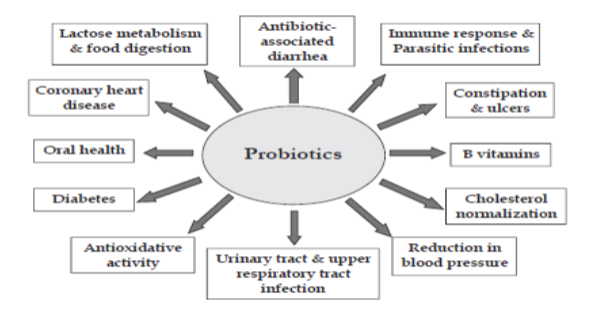Authors: S. N. Chaudhari1, S. B. Palve2
1-Assistant Professor, Department of Food Science & Technology, K. K. Wagh College of Food Technology, Nashik - 422003.
2-Assistant Professor, Department of Food Engineering, K. K. Wagh College of Food Technology, Nashik - 422003.
Email: sonalchaudhari@kkwagh.edu.in
In the industrialized world, functional foods have become a part of an everyday diet and are demonstrated to offer potential health benefits beyond the widely accepted nutritional effects. Currently, the most important and frequently used functional food compounds are probiotics and prebiotics, or they are collectively known as ‘synbiotics’. The term probiotic is derived from two Greek words which literally means “for life”. The first scientist to discover health benefits of probiotics was the immunologist Dr. Eli Metchnikoff who was awarded the Nobel Prize in 1908.
Definition:
Food and Agriculture Organization (FAO) of the United Nations and the World Health Organization (WHO) defines probiotics as “live micro organisms that when administered in adequate amounts confer a health benefit on the host” .
It includes a large range of microorganisms, mainly bacteria but also yeasts. LAB are the most important probiotic known to have beneficial effects on the human gastro-intestinal (GI) tract. These bacteria are Gram-positive and usually live in a non-aerobic environment but they also can survive aerobic conditions.
The examples of probiotics are Lactococcus lactis, Enterococcus faecium, Escherichia coli, Saccharomyces cerevisiae, Saccharomyces boulardii , bifidobacteria etc.
Most probiotic bacteria produce lactic acid. The lactic acid keeps the gut at a low pH, maintains the gut microflora. Probiotics also combat the growth of harmful pathogens that cause foodborne illnesses (i.e. diarrhea) such as Salmonella and Escherichia coli. The probiotics prevent the attachment of these pathogens by competing for similar binding sites on the gut epithelium.
Properties For Effective and Successful Probiotics:
- Probiotic strain should survives the site where it should be active.
- For maximum activity, strain should be able to grow and colonize at this active site.
- It should be tolerated by immune system.
- It should not be pathogenic, mutagenic/ carcinogenic or allergic.
- Probiotics for human should have ‘generally regarded as safe’status, with a proven low risk of inducing or being associated with the etiology of disease.
- Probiotics organisms should preferably be of human origin.
- Probiotic used should also be technologically compatible with the food manufacturing process.
- Foods containing the probiotic bacteria must maintain the characteristics sensory attributes of the traditional food.
- Yogurt is the most common source of probiotics. Yogurt consists of milk (usually from the cow, goat or sheep) fermented by bacteria that modify lactose into lactic acid.
- Fermented milk and fortified fruit juice are common sources of probiotics.
- Miso
- Cheese
- Kefir - Kefir has been a reputable fermented dairy product with many health benefits. Probiotics is one of them.
- Sauerkraut
- Pickles
- Chocolate
- Tofu
- Tempeh - A fermented soybean with a nutty taste food from Indonesia, that has become more popular for probiotics source of food.

Fig. No.1: Health Benefits of Probiotics
- Lactose Maldigestion :
- Bowel Transit :
- Irritable Bowel Syndrome :
- Gastrointestinal Infection :
- Hypertension : Probiotics have been proved beneficial in lowering hypertension by decreasing blood cholesterol level and increasing resistance of LDL to oxidation.
- Inflammation : Some strains of LAB may decrease the inflammation by modulating inflammatory and hypersensitivity responses. This effect is thought to be caused by regulation of inflammatory mediator called cytokines.
- Brain and Mental Health :
Conclusion:
Probiotics are defined as ‘live microorganisms which when administered in adequate amount confer health benefits to the host’ (FAO/WHO, 2002). Alternatively, probiotics have been defined as live microbial feed supplements that beneficially affect the host animal by improving its intestinal microbial balance. At present, several well-characterized strains of
Lactobacilli and
Bifidobacteria are available for human use to reduce the risk of gastrointestinal (GI) infections or treat such infections. Some of the beneficial effects of probiotic consumption include improvement of intestinal health by the regulation of microbiota, and stimulation and development of the immune system, synthesizing and enhancing the bioavailability of nutrients, reducing symptoms of lactose intolerance, and reducing the risk of certain other diseases.
References:
1. Nagpal Ravinder, Kumar Ashwani, Kumar Manoj, Behare Pradip V., Jain Shalini & Yadav Hariom (2012): Probiotics, their health benefits and applications for developing
healthier foods: a review, Federation of European Microbiological Societies Microbiology Letter, 334: 1-15.
2. Kaur, A., Arora M. and Pandove G. (2014): Probiotics and Its Health Benefits, Journal of Global Biosciences, 3(3): 686-693.
3. Iqbal Muhammad Zeeshan, Qadir Muhammad Imran, Hussain Tauqeer, Khalid Hussain Janbaz, Khan Yusra Habib and Ahmad Bashir (2014): Probiotics and their beneficial effects against various diseases, Pakistan Journal of Pharmaceutical Sciences, 27(2): 405-415.
About Author / Additional Info: